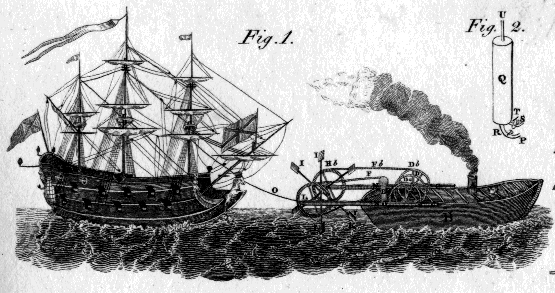Jouffroy
Today, we ride the first successful steamboat. The University of Houston's College of Engineering presents this series about the machines that make our civilization run, and the people whose ingenuity created them.
American schoolchildren learn about Robert Fulton's invention of the steamboat. Actually, what Fulton did was to locate one of the efficient new Watt engines in a warehouse in 1807. He installed it in a well-designed boat and created an immediate commercial success. But when he patented his steamboat, he acknowledged thirty years of earlier work by other people.
Fulton had access to a lot of new technology by 1807, and he put his boat together with an ease that would've been unimaginable just a few years before.
Our story of the first successful steamboat begins in France, with two artillery officers passing time in camp talking about the possible use of steam to power boats. One of them, the Count d'Auxiron, resigned his commission in 1770 to work full time on a boat. By 1772 he'd talked the French government into promising they'd give the first successful steamboat builder an exclusive license to operate the boat for fifteen years.
D'Auxiron installed one of the monstrous old-fashioned Newcomen steam engines in a boat. The engine was so heavy that it sank the boat in the Seine river, and -- after three years of the resulting lawsuits -- d'Auxiron died of apoplexy.
That could have been the end of it. But while d'Auxiron was at work, another young nobleman, the Marquis de Jouffroy, had been thrown into the military prison on the island of Ste Marguerite in connection with a duel. That's the same prison where the famous Man in the Iron Mask had been held. During several years of enforced contemplation, he watched the boats below
When he was released in 1775, Jouffroy made contact with d'Auxiron and his supporters. He rapidly decided that they were on the wrong track, and he left Paris for the town of Lyon to continue the work alone. He developed his own improved version of a Newcomen engine and, in 1783, made a trial run of a new, 150-foot-long boat on the Saone river.
The boat motored past cheering crowds for fifteen minutes until its hull sprang a leak. Jouffroy eased it to shore before anyone spotted the failure, and -- on that fine June day -- he bowed to receive the ovation of the crowd. He sent affidavits, testifying to his success, to Paris, and he waited. After a long debate, the French Academy of Sciences decided that the town of Lyon could never have made a success of something that had failed in Paris, and they denied him the license. Then, a few years later, the French Revolution drove him out of the country.
It wasn't a happy ending for Jouffroy. But his stubborn, irrepressible, driving genius led to the creation of the machine that was soon to open up the Western United States.
I'm John Lienhard, at the University of Houston, where we're interested in the way inventive minds work.
(Theme music)
Flexner, J.T., Steamboats Come True. Boston: Little, Brown, and Company, 1978.
See Episode 1084 for a revised and updated version of this episode.

(From the 1832 Edinburgh Encyclopaedia)
English Patent Drawing of a Steamboat from 1736.